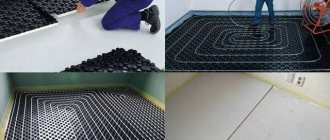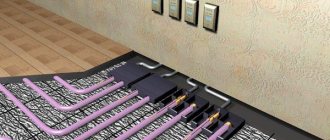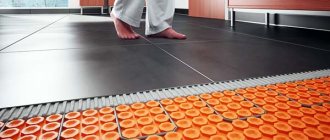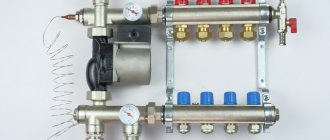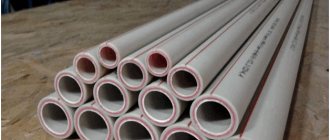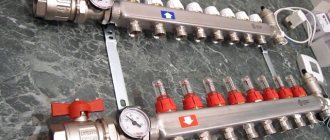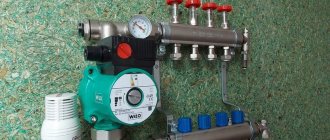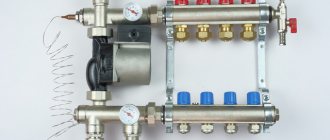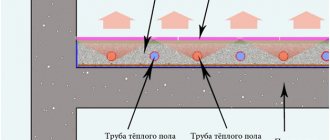When choosing the type of heated floor heating, you have to decide: to install a water or electric heated floor. Electric is easier to install, but expensive to operate. You have to pay a little for water every month, but its installation is complicated and very expensive (if you also install a boiler, mixing unit, and manifold). But today there is a symbiosis of both systems, combining the advantages of both systems: water (liquid) electric heated floor. By the way, this is the only option for a water heated floor without a pump; in any other version the system will not work. There are two offers on the market today:
- From the Korean campaign Daewoo Enertec. Her product is called XL Pipe (XL Pipe).
- The UNIMAT AQUA capillary floor is from another fairly famous Korean campaign, Caleo, but you need to take into account that the products of the Russian branch of this campaign are sold in our country.
The systems are identical only in that pipes filled with liquid are hidden in the screed, and that the coolant is heated by electricity. But the heating elements themselves and the method of heating the liquid are different. Read more about each of the systems below.
Liquid Electric Floor XL Pipe
The novelty of this system is in the structure of the heating element: pipes made of structured polyethylene (thick-walled with a diameter of 20 mm), filled with coolant. A heating cable is inserted inside the entire length. This is not an ordinary cable, but seven strands of chrome-nickel alloy with a Teflon sheath. Pipes with cable and coolant are sealed hermetically. The coolant is static and does not move, therefore, in a system of water electric heated floors, a pump is not needed, like a boiler and a collector.
Warm floor XL Pipe (XL Pipe) from the Korean campaign Daewoo Enertec - electric-water heating
Antifreeze is used as a coolant, so it would be more correct to call this system “liquid electric underfloor heating,” but that’s not the point. Everything should be installed in a screed: this way the heat spreads more evenly. It turns out that this design eliminates the main drawback of water heating: uneven heating, because the temperature of the liquid, and therefore the floor, is the same throughout. This option also does not have the common “disease” of electric heating - an electric-water heated floor is not afraid of locking, that is, you can place and move furniture and large equipment wherever you want.
Warm floors "Daewoo" can be used as the main heating or as simply heated floors to increase comfort: the heating power depends on the step of laying the heating pipes, which you choose yourself.
System composition and operating principle
As with any heating system, to operate and maintain a stable temperature, you need a thermostat (thermostat) with a floor temperature sensor. They are installed in the same way as for conventional electric floors; a special thermostat is needed specifically for this type of equipment.
The XL Pipe system consists of an electric-water heater and a thermostat with temperature sensor
The principle of operation of XL Pipe is as follows: when the power is turned on, the heating cable heats the coolant (this is antifreeze of a special composition). Heating occurs very quickly: the volume of liquid is very small, and the thermal power is decent. When a liquid is heated in a closed volume, increased pressure occurs, which promotes faster heating and uniform heat distribution (nucleate boiling). Therefore, such a warm floor reaches operating temperatures much faster than usual.
The manufacturer of water-electric heated floors Daewoo Enertec guarantees the reliability, environmental friendliness and safety of its system. To absorb excess pressure that occurs when the coolant is heated, an extinguishing system has been developed and patented, stabilizing the state of the heating element. You can probably trust them - the warranty period is 10 years, and the service life is stated to be 50 years. The difficulty is that the system is still new and reviews from the owners of this miracle could not be found.
XL Pipe Specifications
But the best part is this: they say that electric-water heated floors can be repaired. True, only service technicians can carry out the work - special equipment is used. But what is good is that for repairs you do not need to break the entire screed, and it will take several hours to repair the damage. If the integrity of the cable is damaged, the leakage zone is easily determined: liquid seeps out and a stain appears on the screed. At this point you will need to break the tie. Then, having opened the installation box, carry out some manipulations using special equipment. The repair work itself is described in the video.
Why is XL Pipe economical?
Manufacturers of the system claim that the system is more economical to operate than electric floors (20-30% lower electricity bills) and less expensive to install than water floors (no boiler, mixing and manifold units and circulation pump required).
Thus, the savings consist of two parts:
- Less financial costs at the installation stage (compared to the installation of water heated floors).
- Lower monthly heating costs (compared to electric heating).
Due to which installation costs are lower, it is clear: no boiler, mixing and collecting unit, or circulation pump are needed. Requires an electric water pipe and a thermostat with temperature sensor. But about saving on heating, it is necessary to explain: since the coolant does not move, it heats up very quickly. And no losses for heating the air at the mixing, collector unit. All the heat goes to heating the floor. Therefore the costs are lower. At least that's what the manufacturers say.
For large rooms use several circuits
Installation of XL Pipe (XL Pipe)
The entire installation sequence repeats the process of installing water systems down to the smallest detail:
- Thermal insulation of the floor and perimeter of the room.
- Laying a heat-reflecting metallized layer.
- Installation of a fixing system (metal mesh or mounting fixing tape).
- Cable layout. The only difference here is that you need to insert the ends of the pipe not into the collector unit, but into a special mounting box located on the floor. Having sealed the ends of the wires with electrical tape, they are fixed in special grooves, the box lid is tightened with bolts and wrapped with waterproofing tape. After that, the wires from the wiring box are connected to the thermostat (its installation principle is similar to the principles of installing a regulator for a conventional electric floor).
- Filling the screed.
How most XL Pipe systems are installed in a screed
As you can see, water electric heated floors in the installation are practically no different from a water heating device (except for connecting the thermostat and the electrical assembly of the system). After the screed has dried (28 days or less), you can lay the floor covering. You can see the installation sequence in the video.
Preparing the base
The floor surface is cleaned of dirt and construction debris. They also prepare all materials for installation, determine the pipe laying diagram, the installation location of the thermostat and other elements of the system.
Step-by-step installation of XL PIPE underfloor heating
Thermal insulation
If the installation of a heated floor occurs on the ground floor of a private house, where the ceiling is installed above the ground or an unheated room, it is better to use extruded polystyrene foam or mineral wool. The thickness of the insulation must be at least 5 cm. To fix the insulating boards to the concrete base, you can use dowels with plastic heads in the form of umbrellas.
Characteristics of extruded polystyrene foam for thermal insulation of heated floors
It is recommended to lay a 2-5 mm thick lavsan metallized film on the slab insulation. It will be able to effectively reflect all the generated thermal energy into the room. If the height of the rooms does not allow the use of a thick layer of thermal insulation, only lavsan metallized film is allowed.
Installation of heating elements
Plastic reinforcing mesh for screed.
A reinforcing mesh with a cell size of 10x10 cm or 20x20 cm and a wire thickness of 3-5 mm is laid on the prepared surface.
Using plastic clamps, the pipelines are secured to the reinforcing mesh. The distance between the turns should not be less than 5 cm. The recommended gap is 20-30 cm. The bend diameter of the pipelines should be greater than the standard pitch of their installation.
In order not to damage the pipe, it is recommended to cut a piece 80 cm long and perform the necessary manipulations with it. It is bent until the desired coil size is obtained.
When installing pipelines, it is necessary to retreat from the walls at a distance of 5-10 cm. The heating elements must be well secured, especially at bends, so that their position does not change after pouring the screed.
Installation of distribution box
Two ends from the pipeline are inserted into the distribution box (dimensions 180x180x40 mm), which comes with the XL PIPE kit. Such a device is installed on the floor so that its cover is level with the top of the poured screed. The box must be secured to the base to prevent it from moving.
Wire connection diagram in the junction box
This element of the system is also insulated to prevent liquid from entering when pouring the screed. In dry rooms this can be done using ordinary tape, and in wet rooms - using waterproofing sealant.
Installation of a thermostat
Connecting a heated floor to a thermostat
Before installing the thermostat, it is necessary to measure the resistance of the heating cable. It should not differ from the value specified in the instructions. If everything is in order, connect the wires from the heated floor to the temperature controller. Red color corresponds to phase, blue – zero.
The thermostat itself is also connected to the network. The maximum permissible power of the device should be slightly greater than the power of the heating system, but not vice versa. It is also prohibited to connect pipelines longer than 84 m to one thermostat.
The temperature sensor is installed between the turns of heating elements in a corrugated tube with a diameter of 16 mm. The distance from the device to the pipelines should be 2-5 cm. The temperature sensor is also connected to the thermostat.
Filling the screed
After installing all the elements of the system and their secure fixation, begin pouring the screed. It is prepared from Portland cement and sand (ratio 1:3). In order to improve the quality of the screed, plasticizers are added to the solution to increase its durability. Also, a damper tape with a maximum thickness of 10 mm is installed along the contour of the room. It will compensate for the expansion of the screed during heating. The recommended thickness of the screed is 4 cm, the maximum possible is 8 cm.
Proportions of mortar for screed
After the solution reaches the required power, begin laying the flooring. The electric heated floor is put into operation after installation of all elements of the system. [ads-pc-2][ads-mob-2]
Capillary heated floor UNIMAT AQUA
These water-based electric heated floors have a different operating principle. The main difference here is the diameter of the pipes: it is very small, hence the name - capillary. These tubes are connected to a small device, which simultaneously heats the coolant, controls its temperature and creates pressure in the system (closed system).
Since the diameter of the pipes is small, the system contains a small amount of water - up to 6 liters (necessarily distilled) and its heating is handled by a small heater (no more than 2.4 kW). Therefore, to install this version of a liquid-electric floor, a separate input is not required, although it is better to connect it through an RCD and an automatic circuit breaker.
The maximum heating area is 20m2. Therefore, the system is not very suitable for large rooms, although several devices can be installed that operate independently of each other. Warranty period - 5 years.
Composition of the capillary floor system and its capabilities
In order to assemble this type of heating, you will need at least two kits: basic and additional. The basic UNIMAT AQUA kit includes an assembled control unit, two pieces of connecting pipe and an installation kit (bushings, tees and clamps), with which the pipeline is assembled and connected. An additional kit is one or two coils of capillary tubes for different areas (from 10m2 to 20m2). In addition, for installation you will need insulation, damper tape, a heat-reflecting layer and fasteners for tubes, as well as a cement-sand mortar with a plasticizer for pouring the screed (or a special composition).
Basic set • capillary floor UNIMAT AQUA
The main advantage of this system is the fairly large functionality of the control unit. Here's what the capillary system control unit can do:
- Maintain antifreeze mode (temperature +15°C).
- Control either the condition of the coolant or the room temperature of your choice.
- Maintain the power that you set yourself when starting the system (factory setting is 2.4 kW, but you can set it from 0.1 kW to 2.4 kW).
- Using the timer, you can set the system shutdown time.
Installation of UNIMAT AQUA
As with electric heating systems, everything needs to start with choosing the installation location for the control unit. It is located on the wall, at a height of 1-1.2 meters from the floor level. The installation method is hinged, so there is no need to make holes. You need to securely attach the mounting plate, that's all. Please note that the device is plugged into an outlet, so choose a place close to it.
Connecting pipes from the capillary floor will be supplied to the control unit and to lay them you will need grooves in the wall (or you can lay them in a plastic mounting box mounted on the wall).
Installation diagram of capillary floors from Caleo (click on the picture to enlarge)
The installation of capillary tubes is standard: in the screed. There are no differences from the water heating device or from the method described above. The same requirements apply to the base (must be level) and an excellent degree of thermal insulation is desirable. The “pie” and the editing sequence are similar. The laying pattern for the screed is a double snake (see the picture), the laying step is 10-12cm, the distance from the walls is 10-15cm or more. After laying the heating tubes, they are connected using the components from the installation kit with connecting ones (included in the basic kit). The connecting tubes are easy to distinguish - they have a square cross-section. For greater maintainability of the system, it is advisable to place the connection point in a mounting box fixed to the floor. And from it, run solid pipes to the control unit (in a groove or mounting box on the wall). The control unit has special small pipes onto which the connecting tubes are pulled.
Control unit - the heart and brain of the capillary system of the electric water floor
The next stage of installation is filling the system. Distilled water is poured into the receiving hole. Then the system is tested: the heating temperature is set on the control unit and the system begins to operate. After checking, the heating is turned off and the water is not drained. When the coolant has cooled (but not cold), begin pouring the screed. Its thickness is from 3cm to 5cm. The capillary underfloor heating system can be put into operation only after the screed has completely dried (at least 28 days).
Advantages and disadvantages of a capillary heated floor system
This version of the water-electric floor can only be used to increase comfort. It does not have enough power for main heating. The advantage is the safety of the system (no electricity in the floor), which allows it to be installed in wet areas (for example, in the washing compartment of a bathhouse) without any restrictions. On the other hand, the disadvantages of water heated floors remain to some extent: hotter water comes from the block, and therefore the floor warms up unevenly. The disadvantage is not so pronounced due to the recommended double snake when laying pipes, as well as due to the small volume of the system, which allows maintaining a small temperature difference between the supply and return pipelines.
Technical characteristics of UNIMAT AQUA
There is no data on the maintainability of the system, although it is recommended to place the main problem unit - the joining of heating and connecting pipes - in a separate accessible box, which provides for the possibility of repair. All other parts that may fail are located in the control unit, so repairs are possible.
Why is it profitable to make heated floors?
The main advantage of heated floors over all other types of heating is that they are hidden from view and are ideal for families with small children. In addition to the fact that babies can crawl safely, they will not get burned on heat sources that are securely hidden under the finishing coating. There are no drafts in the room where heated floors are installed.
Warm floors reduce heating costs in houses with very high ceilings, where it is difficult to rationally organize heating of the entire volume of the room. In apartments located on the ground floor, above damp, cold basements, heated floors will provide a comfortable microclimate.
In addition, they do not dry out the air, which is especially appreciated by sensitive people prone to allergies. When heated floors are an autonomous type of heating, they will help out on cold days in the off-season. Ceramic tiles, even with the best heating system, remain cold, and here the use of warm floors will help out.
Thus, the decision to install heated floors is for the benefit of the health of family members
It is important to choose which system is best to use.
Results
Water-based electric heated floors are an interesting floor heating option in all aspects. XL Pipe (XL Pipe) seems more advantageous, but it also costs more, but it provides the possibility of using it as the main heating (it has enough power with good insulation). If you simply need a comfortable floor temperature in relatively small rooms, including those with high humidity, then the capillary heated floor UNIMAT AQUA looks more acceptable, although this is also your choice.
Advantages and disadvantages
The system is suitable for any type of flooring.
The XL PIPE flooring system is designed specifically for heating equipment in private houses and cottages. It is very popular due to many advantages:
- Suitable for installation under any substrate: laminate, tile, carpet and linoleum.
- Does not require additional installation of pumps and boilers.
- The cable is in a special liquid, which prevents overheating.
- The system is resistant to rubbing; you can place large furniture on the floor without fear that the cable will be pinched and the system will fail.
- It is possible to repair without opening the screed.
- The function of adjusting the temperature in different rooms has been installed.
Liquid XL PIPE underfloor heating is characterized by the following indicators:
- This is an economical, energy-saving system. 98% of all energy goes to heating the room. Thanks to this, heat is not lost, and the cost of heating is significantly reduced.
- A warm water floor can be easily installed under any type of covering.
- The design is completely safe for humans, as it prevents the radiation of electromagnetic waves.
- Thanks to the innovative design, its reliability and long service life are ensured.
XL PIPE electric water floors are a completely autonomous system. This type of water heating can be installed as the main source of heating. It is not afraid of moisture, so it is suitable for installation in bathrooms and toilets.
